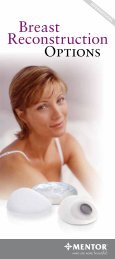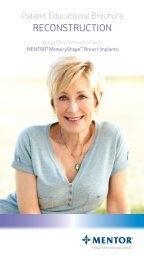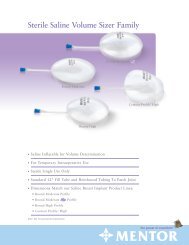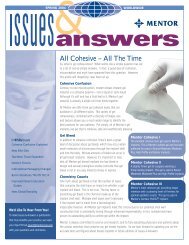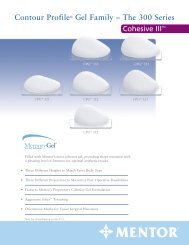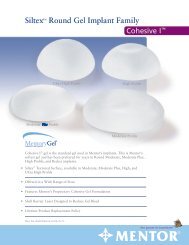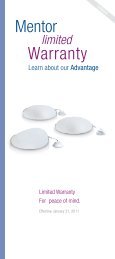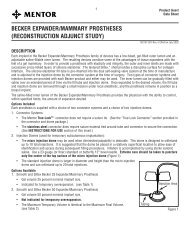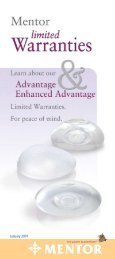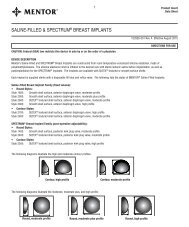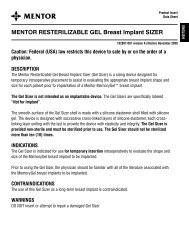Saline-Filled and Spectrum⢠Breast Implants - Mentor
Saline-Filled and Spectrum⢠Breast Implants - Mentor
Saline-Filled and Spectrum⢠Breast Implants - Mentor
You also want an ePaper? Increase the reach of your titles
YUMPU automatically turns print PDFs into web optimized ePapers that Google loves.
<strong>Mentor</strong> Corporation<br />
P990075/S21/A03<br />
<strong>Saline</strong> <strong>Filled</strong> <strong>Breast</strong> <strong>Implants</strong><br />
As additional safety information, Table 5 below shows the 3-year cumulative Kaplan-Meier adverse event rates of first occurrence following implant<br />
replacement (i.e., revision) on a by implant basis for complications occurring in at least 1% of patients. There were 113 augmentation patients <strong>and</strong> 70<br />
reconstruction patients who underwent replacement of their implants. For those patients, follow-up data were available on 120 augmentation implants <strong>and</strong><br />
76 reconstruction implants.<br />
Table 5a: SPS: 3-Year Cumulative First Occurrence Kaplan-Meier Adverse Event Risk Rates (95% Confidence Interval) Following<br />
Augmentation Implant Replacement, by Implant<br />
Complication Following Replacement of<br />
3-Year Risk Rate<br />
95% CI<br />
Augmentation <strong>Implants</strong><br />
N = 120 implants<br />
Reoperation 15.8% (8.9, 22.3)<br />
Wrinkling 14.6% (8.0, 21.2)<br />
Implant Removal 12.1% (5.9, 18.3)<br />
Capsular Contracture III/IV <strong>and</strong> grade unknown 9.1% (3.0, 15.1)<br />
Leakage/Deflation 4.4% (0.0, 8.8)<br />
Asymmetry 3.8% (0.1, 7.5)<br />
<strong>Breast</strong> Pain 3.0% (0.0, 5.5)<br />
Hematoma 1.7% (0.0, 4.1)<br />
Hypertrophic Scarring 2.0% (0.0, 4.8)<br />
Table 5b: SPS: 3-Year Cumulative First Occurrence Kaplan-Meier Adverse Event Risk Rates (95% Confidence Interval) Following Reconstruction<br />
Implant Replacement, by Implant<br />
Complication Following Replacement of<br />
3-Year Risk Rate<br />
95% CI<br />
Reconstruction <strong>Implants</strong><br />
N = 76 implants<br />
Reoperation 30.6% (18.4, 43.0)<br />
Leakage/Deflation 22.6% (9.9, 35.3)<br />
Implant Removal 21.1% (10.6, 31.5)<br />
Capsular Contracture III/IV <strong>and</strong> grade unknown 18.9% (8.5, 29.1)<br />
Asymmetry 17.1% (5.8, 28.3)<br />
Wrinkling 16.0% (5.0, 27.0)<br />
<strong>Breast</strong> Pain 13.1% (2.9, 23.3)<br />
Infection 4.7% (0.0, 9.9)<br />
Irritation/Inflammation 3.0% (0.0, 7.1)<br />
Seroma 3.0% (0.0, 7.0)<br />
Extrusion 1.9% (0.0, 5.4)<br />
Hypertrophic Scarring 1.6% (0.0, 4.6)<br />
Hematoma 1.5% (0.0, 4.5)<br />
Necrosis 1.4% (0.0, 4.2)<br />
<strong>Breast</strong> Disease <strong>and</strong> Connective Tissue Disease (CTD)<br />
<strong>Breast</strong> disease <strong>and</strong> CTD were reported in some patients through 3 years. These data should be interpreted with the precaution in that there was no<br />
comparison group of similar women without implants. New cases of breast cancer were reported in 2 augmentation patients through 3 years. Tables 6a<br />
<strong>and</strong> 6b summarize post-implant observations from the SPS pertaining to CTD. Unconfirmed reports were based on self reports by the patients. Confirmed<br />
reports were based on a diagnosis by a physician.<br />
8<br />
Attachment 2



